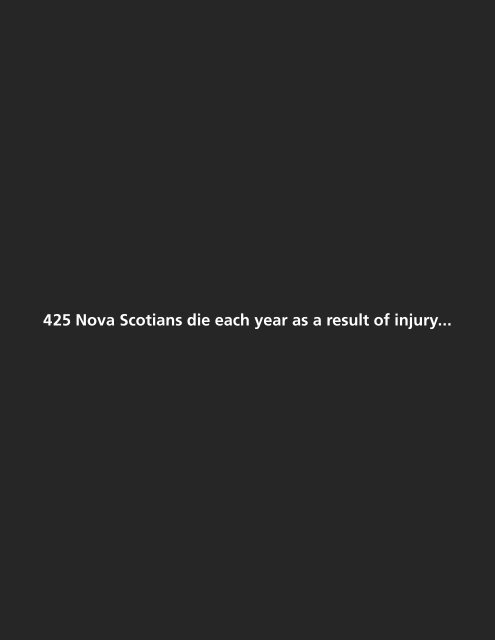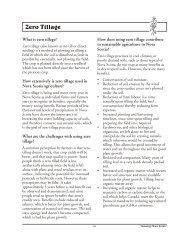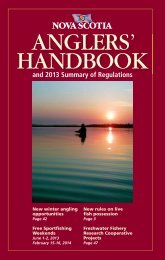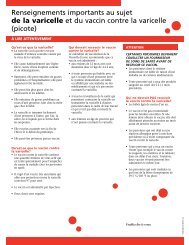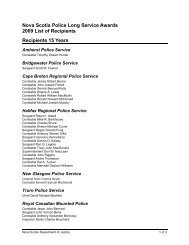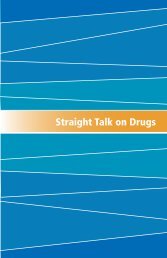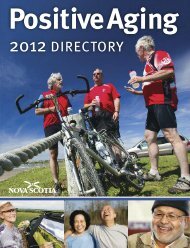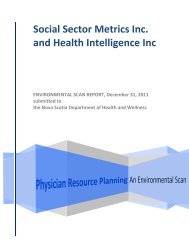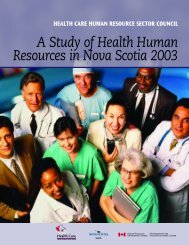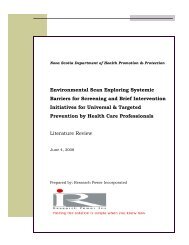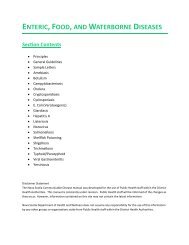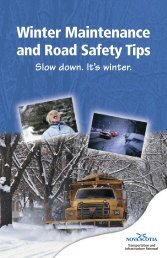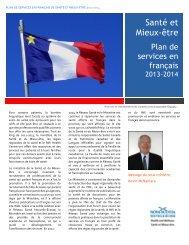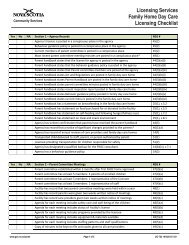Nova Scotia's Renewed Injury Prevention Strategy - Government of ...
Nova Scotia's Renewed Injury Prevention Strategy - Government of ...
Nova Scotia's Renewed Injury Prevention Strategy - Government of ...
- No tags were found...
Create successful ePaper yourself
Turn your PDF publications into a flip-book with our unique Google optimized e-Paper software.
<strong>Nova</strong> Scotia’s <strong>Renewed</strong> <strong>Injury</strong> <strong>Prevention</strong> <strong>Strategy</strong>Taking It to the Next Level
Taking It to the Next Level <strong>Nova</strong> Scotia’s <strong>Renewed</strong> <strong>Injury</strong> <strong>Prevention</strong> <strong>Strategy</strong>Department <strong>of</strong> Health Promotion and Protection<strong>Injury</strong> Free <strong>Nova</strong> ScotiaDesign: Laura Graham Design© Crown copyright, Province <strong>of</strong> <strong>Nova</strong> Scotia, 2009ISBN: 978-1-55457-323-3To download additional copies please visit the Department <strong>of</strong> Health Promotion and Protection website:http://www.gov.ns.ca/hppApril 2010•
Table <strong>of</strong> ContentsConsider This ............................................................................................................................5Acknowledgements ...................................................................................................................Minister’s Message..................................................................................................................9Executive Summary................................................................................................................11<strong>Strategy</strong> Highlights ......................................................................................................12Why Do We Need an <strong>Injury</strong> <strong>Prevention</strong> <strong>Strategy</strong>?..............................................................15Overview ....................................................................................................................15<strong>Injury</strong>: The Facts...........................................................................................................16Global Snapshot...........................................................................................16Canadian Snapshot ......................................................................................16<strong>Nova</strong> Scotia Snapshot...................................................................................17Human Impacts............................................................................................18Impact on <strong>Nova</strong> Scotia’s Health-care System .................................................18Economic and Social Impact <strong>of</strong> <strong>Injury</strong> ............................................................19A Brief History <strong>of</strong> <strong>Injury</strong> <strong>Prevention</strong> in <strong>Nova</strong> Scotia........................................................20A Collective Effort .......................................................................................................22<strong>Renewed</strong> Purpose .......................................................................................................22Process for Developing the <strong>Renewed</strong> <strong>Strategy</strong>..................................................................23Shared Responsibility for Success........................................................................................25Links to Other Strategies and Initiatives ............................................................................27<strong>Nova</strong> Scotia Alcohol <strong>Strategy</strong> .......................................................................................27<strong>Strategy</strong> for Children and Youth ...................................................................................27<strong>Strategy</strong> for Positive Aging...........................................................................................27Crime <strong>Prevention</strong> <strong>Strategy</strong> ...........................................................................................27What Are We Trying to Achieve?...........................................................................................29Key Measures <strong>of</strong> Success .............................................................................................29Short-term Measures....................................................................................29Intermediate Measures.................................................................................29Long-term Measures ....................................................................................29<strong>Renewed</strong> <strong>Nova</strong> Scotia <strong>Injury</strong> <strong>Prevention</strong> <strong>Strategy</strong>.............................................................31Framework..................................................................................................................31Vision and Purpose......................................................................................................32Vision ..........................................................................................................32Purpose .......................................................................................................32Taking It to the Next Level <strong>Nova</strong> Scotia’s <strong>Renewed</strong> <strong>Injury</strong> <strong>Prevention</strong> <strong>Strategy</strong>•
Key Concepts ..............................................................................................................34Population Health.........................................................................................34The Three E’s <strong>of</strong> <strong>Injury</strong> <strong>Prevention</strong>..................................................................37Balancing Risk..............................................................................................38Guiding Principles .......................................................................................................39<strong>Strategy</strong> Priorities ........................................................................................................40Priority Issues...............................................................................................40Priority Populations ......................................................................................40Priority Settings............................................................................................40Strategic Directions .....................................................................................................411. Integration ...............................................................................................412. Leadership and Capacity Building .............................................................423. Surveillance, Research, and Evaluation ......................................................424. Advocacy..................................................................................................43Conclusion...............................................................................................................................45References ..............................................................................................................................47Taking It to the Next Level <strong>Nova</strong> Scotia’s <strong>Renewed</strong> <strong>Injury</strong> <strong>Prevention</strong> <strong>Strategy</strong>•
Taking It to the Next Level <strong>Nova</strong> Scotia’s <strong>Renewed</strong> <strong>Injury</strong> <strong>Prevention</strong> <strong>Strategy</strong>6
AcknowledgementsMany individuals and organizations have madesignificant contributions to the renewal <strong>of</strong> the <strong>Nova</strong>Scotia <strong>Injury</strong> <strong>Prevention</strong> <strong>Strategy</strong>. This renewedstrategy builds heavily on the successes we’veachieved together in addressing this major publichealth problem over the past decade. Much <strong>of</strong> thissuccess can be attributed to the spirit <strong>of</strong>collaboration among public health advocates andinjury prevention practitioners in our province. Thiscollaborative spirit supported the development <strong>of</strong>the renewed strategy and continues to set the stageas we prepare to work together in the coming years.To all who participated in one form or another inrenewing the strategy, we are truly grateful.While it is impossible to single out everyone whocontributed, we would like to acknowledge twopeople who played significant roles: CatherineKennedy, for her background research, analysis <strong>of</strong>the stakeholder surveys, and contribution to thestrategy writing, and Jim Neale <strong>of</strong> Peak PerformanceConsulting Services, for his contributions to thedesign and facilitation <strong>of</strong> the consultation process.We would also like to acknowledge the members <strong>of</strong>the <strong>Strategy</strong> Renewal Advisory Committee for theirexpertise and guidance. This dedicated group <strong>of</strong>individuals, representing the many sectors involvedin injury prevention, assisted in the design <strong>of</strong> theconsultation process, lent their facilitation talents tothe Renewal Symposium, provided input into thedesign <strong>of</strong> the renewed strategy, and helped organizeexpert focus groups. We are extremely grateful forthe above-and-beyond efforts <strong>of</strong> this group.Robert Strang, MD, MHSC, FRCPCChief Public Health OfficerDepartment <strong>of</strong> Health Promotion and Protectio• Susan Brushett, <strong>Injury</strong> Free <strong>Nova</strong> Scotia• Morris Green, Department <strong>of</strong> Health Promotionand Protection• Deanna Beck, Annapolis Valley Safe CommunitiesCoalition• Paul Fynes, South Shore Safe Communities• Angela Davis, Canadian Mental HealthFoundation, <strong>Nova</strong> Scotia Division• Jennifer Girard, EHS <strong>Nova</strong> Scotia Trauma Program• Holly Gillis and Morgane Stocker, Capital Health,Public Health Services• Sandra Newton, IWK Child Safety Link• Julie Stover, Transportation and InfrastructureRenewalLastly, the Department <strong>of</strong> Health Promotion andProtection and <strong>Injury</strong> Free <strong>Nova</strong> Scotia are gratefulfor the opportunity to co-lead the development <strong>of</strong>the renewed strategy. Our shared effortdemonstrates the solid commitment <strong>of</strong> governmentand community to work together to make <strong>Nova</strong>Scotia a healthier and safer place to grow, live,work, play, and age.Natalie Yanchar MD, MSc, FRCSCPresident<strong>Injury</strong> Free <strong>Nova</strong> ScotiaTaking It to the Next Level <strong>Nova</strong> Scotia’s <strong>Renewed</strong> <strong>Injury</strong> <strong>Prevention</strong> <strong>Strategy</strong>7
Taking It to the Next Level <strong>Nova</strong> Scotia’s <strong>Renewed</strong> <strong>Injury</strong> <strong>Prevention</strong> <strong>Strategy</strong>8
Minister’s MessageDespite all <strong>of</strong> the advances made in improving thelives <strong>of</strong> <strong>Nova</strong> Scotians, injury remains the leadingcause <strong>of</strong> death and disability during the first 45 years<strong>of</strong> life and costs <strong>Nova</strong> Scotians $518 million each year.<strong>Injury</strong> especially impacts our youth, causing moredeaths than all diseases and other threats to healthcombined for those aged one to 19. It’s also a leadingcause <strong>of</strong> hospitalization and injury places great stresson our emergency departments and other health-careresources.We have all been affected by injury in one way oranother. It may be someone close to us like a familymember, friend, or co-worker. Or it may be someonethat we know <strong>of</strong>. In the end, we have all heard aboutsomeone, somewhere, who has had an injury.The renewed injury prevention strategy has beendeveloped collaboratively with stakeholders andcreates a shared agenda for the next 3-5 years. WhileHPP leads the strategy, its success is driven by thecollective efforts <strong>of</strong> many government departments,community organizations, and partners.Taking It to the Next Level is the title <strong>of</strong> the renewedstrategy, reflecting the necessity <strong>of</strong> building resilientpopulations and focusing on those factors which leadto poor health and a lack <strong>of</strong> safety. This approach willreduce injuries and improve all aspects <strong>of</strong> the health<strong>of</strong> <strong>Nova</strong> Scotians. The renewed strategy alsorecognizes the need for greater integration andcollaboration with others working in health promotionand social justice.The concept <strong>of</strong> injury prevention is broad and can bechallenging to understand. Injuries have manycauses—car crashes, falls, violence, drownings orrecreation, to name just a few. Injuries take manyforms—broken bones, s<strong>of</strong>t-tissue damage, spinal cord,brain injuries—and have various degrees <strong>of</strong> severity.Injuries happen in every setting, from our streets andhighways to schools, workplaces, the outdoors, andeven in our homes. <strong>Injury</strong> prevention encompasses all<strong>of</strong> these things.Regardless <strong>of</strong> the cause or type, all injuries haveseveral common elements:• They impact the lives <strong>of</strong> <strong>Nova</strong> Scotians every daybut, remain largely invisible.• They rarely result from a single cause. Many factors,<strong>of</strong>ten beyond the control <strong>of</strong> individuals, contributeto an injury-causing event.• Injuries are not accidents. They are almost alwayspreventable.I am pleased to endorse the renewed strategy andvery encouraged by the ideas it proposes to take injuryprevention to the next level. <strong>Nova</strong> Scotia has been andwill continue to be a leader in improving the health <strong>of</strong>communities.I look forward to working with my colleagues toconsider ways to meaningfully support this strategy.We all share a vision to live in a province wherepeople are healthier and safer. My sincere thanks to allthe committed individuals and organizations whohave worked so hard to improve the safety and health<strong>of</strong> <strong>Nova</strong> Scotians in the past, and best wishes forsuccess in your continuing contributions to this vitaleffort.The Honourable Maureen MacDonaldMinisterDepartment <strong>of</strong> Health Promotion and ProtectionTaking It to the Next Level <strong>Nova</strong> Scotia’s <strong>Renewed</strong> <strong>Injury</strong> <strong>Prevention</strong> <strong>Strategy</strong>9
Taking It to the Next Level <strong>Nova</strong> Scotia’s <strong>Renewed</strong> <strong>Injury</strong> <strong>Prevention</strong> <strong>Strategy</strong>10
Executive SummaryThe <strong>Nova</strong> Scotia <strong>Injury</strong> <strong>Prevention</strong> <strong>Strategy</strong> waslaunched in 2004 as a plan for maximizing theability <strong>of</strong> prevention partners to work together totackle injury prevention as a public health issue.Building on our accomplishments, and mindful <strong>of</strong> thegrowing knowledge base related to the distribution<strong>of</strong> injury across populations, it is time to update theplan to reflect the current environment and latestevidence. We must continue to work together in acoordinated and strategic way to further advanceprevention efforts in <strong>Nova</strong> Scotia. The renewed <strong>Nova</strong>Scotia <strong>Injury</strong> <strong>Prevention</strong> <strong>Strategy</strong> will enable us to dothis.Belonging to all <strong>Nova</strong> Scotians, this renewedstrategy provides a collective path forward for thenext three to five years.As a significant public health issue, injury preventionshould not stand apart from other initiatives as aseparate area <strong>of</strong> policy and practice. It takes thecombined efforts <strong>of</strong> many sectors, well beyond thosejust concerned with health, to prevent injuries. <strong>Injury</strong>shares many <strong>of</strong> the same root causes as other publichealth issues and much can be accomplished byworking on all <strong>of</strong> these problems together instead <strong>of</strong>in isolation.The title <strong>of</strong> the renewed injury prevention strategy isTaking It to the Next Level. This represents a call toaction. It reflects the need to make injury preventionmore visible as a critical aspect <strong>of</strong> healthycommunities, which includes ensuring communitiesare safe. It means focusing on reducing disparityacross the entire population, as well as focusing onthe sub-populations where the greatest disparities ininjury rates are evident. By taking it to the next level,we will increase our impact not just in reducinginjuries but also by improving all aspects <strong>of</strong> thehealth <strong>of</strong> <strong>Nova</strong> Scotians.While the causes <strong>of</strong> injury and the solutions forpreventing them are fairly well understood,prevention initiatives are complicated by our need tounderstand a range <strong>of</strong> factors—why injury occurs,where, and to whom—and how these factors comeinto play at various levels. To realize significantreductions in the injury rate we need comprehensiveinterventions that are carefully woven together andstrategically coordinated. Communities, institutions(e.g., schools, workplaces), all levels <strong>of</strong> government,families, and individuals all have a role to play ininjury prevention.The renewed strategy builds on what has beenachieved since the introduction <strong>of</strong> the originalstrategy in 2004. Its purpose is to providestakeholders, both within and outside <strong>of</strong> thetraditional boundaries <strong>of</strong> injury prevention, with aframework to guide our collective activities, fromplanning and development through toimplementation and evaluation.The renewed strategy brings the work <strong>of</strong> the injuryprevention community in line with the currentenvironment. It provides us with an opportunity tobuild on what is already working, begin to addressemerging priorities, and adopt new ways <strong>of</strong> workingthat will take our efforts to new heights. Therenewed strategy provides a strategic andcoordinated approach to preventing injuries in thefuture.Success in creating a healthier and safer <strong>Nova</strong> Scotiarequires a high level <strong>of</strong> collaboration amongindividuals, families, communities, non-governmentalorganizations, and all levels <strong>of</strong> government. It mustalso involve sectors and stakeholders outside thetraditional boundaries <strong>of</strong> injury prevention.Even those who do not see themselves as having aprimary responsibility in injury prevention have a roleto play in the renewed strategy. Success depends onthe involvement <strong>of</strong> all stakeholders who have eitherthe mandate or ability to positively influence theissue <strong>of</strong> injury.Taking It to the Next Level <strong>Nova</strong> Scotia’s <strong>Renewed</strong> <strong>Injury</strong> <strong>Prevention</strong> <strong>Strategy</strong>11
Ultimately, the renewed strategy belongs to all <strong>Nova</strong>Scotians and accountability for its success is sharedamong many sectors and stakeholders. TheDepartment <strong>of</strong> Health Promotion and Protection willcontinue to provide provincial leadership and facilitatecoordination <strong>of</strong> the strategy. However, everyone has arole to play in making <strong>Nova</strong> Scotia a healthier andsafer place. We will only succeed if all partners stepforward and contribute to the implementation <strong>of</strong> therenewed strategy. It is a shared responsibility.Guiding PrinciplesDrawing on the vision and key conepts for the strategy,these principles will guide our work to address injury:• evidence-informed• collective effort• responsive• dynamic• integrated• culturally competentTaking It to the Next Level <strong>Nova</strong> Scotia’s <strong>Renewed</strong> <strong>Injury</strong> <strong>Prevention</strong> <strong>Strategy</strong><strong>Strategy</strong> HighlightsVisionEveryone in <strong>Nova</strong> Scotia working together to createhealthy and safe communities.PurposeThe strategy serves as an integrated andcomprehensive guide for our collective efforts to createhealthy communities and thereby reduce injuries.Key ConceptsThere are six interrelated concepts—grounded inevidence and best practices, that are integral to ourwork in preventing injury. These six key concepts areused nationally and internationally to promote healthand lead to a reduction in illness and injuries. Thesekey concepts, listed below, must be applied in ourinjury prevention work in <strong>Nova</strong> Scotia.• population health- health promotion- health disparities- determinants <strong>of</strong> health• the three E’s <strong>of</strong> injury prevention• balancing risk<strong>Strategy</strong> PrioritiesThe priorities are based on surveillance, research, andconsultation. These priorities have been established toguide injury prevention planning and resourceallocation.Priority Issues• seniors’ falls• suicide and attempted suicide• road safetyPriority Populations• children and youth• older <strong>Nova</strong> Scotians (seniors)• other populations at increased risk <strong>of</strong> injuryPriority Settings• schools• workplaces• homes• communities• roads and streets• health care settings• recreation and leisure settings12
Strategic DirectionsThe strategic directions are the pathways forrealizing the vision <strong>of</strong> the renewed strategy.The strategic directions are• integration• leadership and capacity building• surveillance, research, and evaluation• advocacyYou are invited to join us as we work to create ahealthier and safer <strong>Nova</strong> Scotia for all to grow, live,work, play, and age.Taking It to the Next Level <strong>Nova</strong> Scotia’s <strong>Renewed</strong> <strong>Injury</strong> <strong>Prevention</strong> <strong>Strategy</strong>13
Taking It to the Next Level <strong>Nova</strong> Scotia’s <strong>Renewed</strong> <strong>Injury</strong> <strong>Prevention</strong> <strong>Strategy</strong>14
Why Do We Need an <strong>Injury</strong><strong>Prevention</strong> <strong>Strategy</strong>?Overview<strong>Injury</strong> remains a leading cause <strong>of</strong> death anddisability throughout the world, killing five millionpeople annually. In Canada, injury is the leadingcause <strong>of</strong> death and disability during the first 45years <strong>of</strong> life and the fourth leading cause <strong>of</strong> deathoverall. 1 In 2004, injuries killed 13,667 Canadiansand cost our economy $19.8 billion. 2 In <strong>Nova</strong> Scotia,injury kills 425 people annually and causes thedeaths <strong>of</strong> more young people aged 1–19 years thanall other causes <strong>of</strong> death combined. 3 <strong>Injury</strong> is also amajor cause <strong>of</strong> death and disability in lateradulthood and the senior years. In 2004 injury cost<strong>Nova</strong> Scotians $518 million. 4Defining injuryAn injury is the physical damage that resultswhen the human body is suddenly subjected toenergy in amounts that exceed the threshold <strong>of</strong>physiological tolerance or from the lack <strong>of</strong> oneor more <strong>of</strong> the vital elements (such as oxygen orheat). The energy could be mechanical, thermal,chemical, electrical, or radiant.Injuries are usually defined by intention. Themain causes <strong>of</strong> unintentional injuries are falls,motor vehicle crashes, drownings, and burns.Intentional injury includes physical force againstoneself, another person, or group or communitythat results in injury, death, mental harm, ormaldevelopment or deprivation. 5<strong>Injury</strong> has a staggering impact on the health andsustainability <strong>of</strong> our province, whether measured interms <strong>of</strong> the human, social or economic impacts. Asa province, we are striving to ensure every <strong>Nova</strong>Scotian is safe, has the opportunity to contribute in ameaningful way and feels valued within theircommunity. <strong>Injury</strong> prevention plays a key role in theachievement <strong>of</strong> this goal.<strong>Injury</strong> prevention efforts in <strong>Nova</strong> Scotia date backmany decades, from early work in water, rail, androad safety to the more recent development <strong>of</strong> the<strong>Nova</strong> Scotia <strong>Injury</strong> <strong>Prevention</strong> <strong>Strategy</strong> in 2004, thefirst initiative <strong>of</strong> its kind in Canada. In 2006 the<strong>Nova</strong> Scotia strategy was recognized by the WorldHealth Organization (WHO) as an example <strong>of</strong> asuccessful sub-national injury prevention policy. 7Although past prevention efforts have resulted in adecrease in injuries, there is clearly much more to bedone. The reality is that injury prevention has notkept pace with other public health interventionssuch as tobacco control or infectious diseaseprevention programs. Despite its devastatingimpacts, injury has largely remained an invisibleepidemic. As a significant public health issue, injuryshould not stand apart from other initiatives as aseparate area <strong>of</strong> policy and practice. It takes thecombined efforts <strong>of</strong> many sectors, well beyond thosejust concerned with health, to prevent injuries. <strong>Injury</strong>shares many <strong>of</strong> the same root causes as other publichealth issues and much can be accomplished byworking on all <strong>of</strong> these problems together instead <strong>of</strong>in isolation.Taking It to the Next Level <strong>Nova</strong> Scotia’s <strong>Renewed</strong> <strong>Injury</strong> <strong>Prevention</strong> <strong>Strategy</strong>15
The title <strong>of</strong> <strong>Nova</strong> Scotia’s renewed injury preventionstrategy is Taking It to the Next Level. This representsa call to action. It reflects the need to make injuryprevention more visible as a critical aspect <strong>of</strong> healthycommunities, which includes ensuring communitiesare safe. It means focusing on reducing disparityacross the entire population, as well as focusing onthe sub-populations where the greatest disparities ininjury rates are evident. By taking it to the next level,we will increase our impact not just in reducinginjuries but also by improving all aspects <strong>of</strong> thehealth <strong>of</strong> <strong>Nova</strong> Scotians.<strong>Injury</strong>: The FactsUnderstanding the problem is the first step in astrategic approach to improve the health <strong>of</strong> thepopulation. The following subsections describe thehuman, health system, and economic impacts <strong>of</strong>injury. By understanding the problem, we can beginto identify priorities and formulate plans forprevention efforts. This first step will also allow us toeffectively measure the impact <strong>of</strong> our work toprevent injuries over time.-Taking It to the Next Level <strong>Nova</strong> Scotia’s <strong>Renewed</strong> <strong>Injury</strong> <strong>Prevention</strong> <strong>Strategy</strong>While the causes <strong>of</strong> injury and the solutions forpreventing them are fairly well understood,prevention initiatives are complicated by our need tounderstand a range <strong>of</strong> factors—why injury occurs,where, and to whom—and how these factors comeinto play at various levels. To realize significantreductions in the injury rate we need comprehensiveinterventions that are carefully woven together andstrategically coordinated. Communities, institutions(e.g., schools, workplaces), all levels <strong>of</strong> government,families, and individuals all have a role to play ininjury prevention.The <strong>Nova</strong> Scotia <strong>Injury</strong> <strong>Prevention</strong> <strong>Strategy</strong> waslaunched in 2004 as a plan for maximizing theability <strong>of</strong> prevention partners to work together totackle injury prevention as a public health issue.Building on our accomplishments, and mindful <strong>of</strong> thegrowing knowledge base related to the distribution<strong>of</strong> injury across populations, it is time to update theplan to reflect the current environment and latestevidence. We must continue to work together in acoordinated and strategic way to further advanceprevention efforts in <strong>Nova</strong> Scotia. The renewed <strong>Nova</strong>Scotia <strong>Injury</strong> <strong>Prevention</strong> <strong>Strategy</strong> will enable us to dothis, to take our work to the next level.Belonging to all <strong>Nova</strong> Scotians, this renewedstrategy provides a collective path forward for thenext three to five years.Global Snapshot• <strong>Injury</strong> kills 5 million people each year, equivalentto nearly one-seventh <strong>of</strong> the Canadianpopulation. 8• Injuries account for 9% <strong>of</strong> all deaths globally, asmany as the total number <strong>of</strong> deaths from HIV,malaria and tuberculosis combined. 9• Injuries account for 12% <strong>of</strong> the total burden <strong>of</strong>disease worldwide. 10• Globally, road traffic injuries, falls, suicide, andinterpersonal violence are the leading causes <strong>of</strong>injury-related deaths. 11Canadian SnapshotIn Canada in 2004,• There were 13,667 injury-related deaths.• There were 3.1 million emergency departmentvisits.• There were more than 210,000 injury-relatedhospitalizations.• Just over 67,500 Canadians were disabled by aninjury.• The leading causes <strong>of</strong> injury-related deaths andhospitalizations were road traffic injuries, suicideand suicide attempts, and falls.16
Putting it in perspectiveThe injury-related deaths <strong>of</strong> 425 <strong>Nova</strong> Scotianseach year is almost double the number <strong>of</strong>people lost in the tragic crash <strong>of</strong> Swissair Flight111 <strong>of</strong>f the coast <strong>of</strong> <strong>Nova</strong> Scotia in 1998.Over a 10-year period, this loss <strong>of</strong> life (4,250people) equates to losing the entire population<strong>of</strong> a town roughly the size <strong>of</strong> Antigonish orStellarton.<strong>Nova</strong> Scotia SnapshotBased on a review <strong>of</strong> injury deaths for the period2001–2007 13 ,• On average, 425 <strong>Nova</strong> Scotians die each year as aresult <strong>of</strong> injury.• More than half <strong>of</strong> all deaths among males underage 40 were the result <strong>of</strong> injury.• One-third <strong>of</strong> all deaths among females under age40 were the result <strong>of</strong> injury.• Across all ages, males accounted for 65% <strong>of</strong>injury-related deaths.• <strong>Injury</strong> is a particular threat to youth, accountingfor 67% <strong>of</strong> deaths among <strong>Nova</strong> Scotians aged15–29 years.• <strong>Injury</strong> killed more children aged 1–19 years thanall other causes <strong>of</strong> death combined.• Approximately one youth died from an injury eachweek in <strong>Nova</strong> Scotia.• An average <strong>of</strong> 108 people each year, mostlyseniors, died as a result <strong>of</strong> a fall, representingnearly 26% <strong>of</strong> all injury-related deaths. Femalesaccounted for 57% <strong>of</strong> fall-related deaths.• On average, 93 people died by suicide each year.Of these, 83% were male.• On average, 80 people died each year as a result<strong>of</strong> car crashes. Males accounted for nearly 75% <strong>of</strong>these deaths.• On average, 13 people died by homicide eachyear. More than three-quarters <strong>of</strong> them were male.Based on a review <strong>of</strong> injury-related hospitalizationsfor the period 2001–2007 14 ,• There were nearly 43,000 injury-relatedhospitalizations in <strong>Nova</strong> Scotia, an average <strong>of</strong> 17hospitalizations per day and 6,130 per year.• <strong>Injury</strong> consumed more than 600,000 hospitaldays, an average <strong>of</strong> nearly 86,000 per year. Thismeans that on any given day, 236 <strong>of</strong> theprovince’s hospital beds were occupied by injured<strong>Nova</strong> Scotians.• <strong>Injury</strong> accounted for 7% <strong>of</strong> the total number <strong>of</strong>hospitalizations. These hospitalizations wereevenly split among males and females.• Falls resulted in an average <strong>of</strong> 3,317hospitalizations each year. Females accounted forjust over 61% <strong>of</strong> the total. Fall-related injuriesmade up 54% <strong>of</strong> the injury-relatedhospitalizations.• Motor vehicle crashes contributed to an average<strong>of</strong> 636 injury-related hospitalizations each year.Males accounted for 68% <strong>of</strong> thesehospitalizations. Motor vehicle crashes representjust over 10% <strong>of</strong> the total number <strong>of</strong> injuryrelatedhospitalizations.• Self-harm, including suicide attempts, accountedfor about 9% <strong>of</strong> injury-related hospitalizations. Anaverage <strong>of</strong> 548 self-harm-related hospitalizationsoccurred each year, with females accounting for56% <strong>of</strong> the total.• Assaults represented 4% <strong>of</strong> all injury-relatedhospitalizations (an average <strong>of</strong> 234hospitalizations per year). Males accounted fornearly 85% <strong>of</strong> these hospitalizations.Taking It to the Next Level <strong>Nova</strong> Scotia’s <strong>Renewed</strong> <strong>Injury</strong> <strong>Prevention</strong> <strong>Strategy</strong>17
According to the 2009 report on The EconomicBurden <strong>of</strong> <strong>Injury</strong> in Canada 15 ,• In 2004 injury caused nearly 90,000 emergencydepartment visits in <strong>Nova</strong> Scotia.• In 2004 almost 1,700 <strong>Nova</strong> Scotians werepartially disabled by an injury and another 134were completely disabled.When compared to other provinces in Canada, <strong>Nova</strong>Scotia ranks third lowest in overall injury-relatedhospitalizations and fourth lowest for injury-relateddeaths. While this comparison suggests <strong>Nova</strong> Scotiais performing better than many other provinces, itdoes not change that fact that injury continues tohave a devastating impact on the lives <strong>of</strong> <strong>Nova</strong>Scotians and on the sustainability <strong>of</strong> <strong>Nova</strong> Scotia’seconomy and society. 16Social impacts <strong>of</strong> brain injuriesResearch in the U.S. has established linksbetween traumatic brain injury (TBI) andincarceration. Many prisoners experienceproblems that not only complicate theirmanagement and treatment in prison, but alsopose challenges when they are released. 17Canadian research that surveyed men andwomen in homeless shelters and meal programsrevealed that 53% <strong>of</strong> them had some level <strong>of</strong>TBI, and 12% had moderate or severe braininjuries. For 70% <strong>of</strong> the people surveyed, theirfirst TBI occurred before they were homeless. 18Human ImpactsTaking It to the Next Level <strong>Nova</strong> Scotia’s <strong>Renewed</strong> <strong>Injury</strong> <strong>Prevention</strong> <strong>Strategy</strong><strong>Injury</strong> takes an immeasurable toll on individuals,families, friends, workplaces, schools, andcommunities. When someone is killed or disabled byan injury, the effects are devastating and longlasting. For people with a serious injury, theconsequences can be permanent and include chronicpain, loss <strong>of</strong> independence, disability ordisfigurement, depression, and economic hardship.Even less-serious injuries have impacts, such as timeaway from work, school or caregivingresponsibilities.The consequences <strong>of</strong> injury also go well beyondphysical harm. <strong>Injury</strong> also affects mental, emotionaland spiritual health, and the degree to which peopleremain connected to their families and friends. Theimpact <strong>of</strong> illness and disability on relationships isalso pronounced. There is considerable research onthe role <strong>of</strong> social support in positive healthoutcomes, but relatively little on how chronicconditions resulting from illness and injury cancreate relationship challenges that few peopleexpect or know how to address. 19The impact <strong>of</strong> a fallA senior who suffers a broken hip will requireparamedics to stabilize and transport him orher to an emergency department. X-rays orother diagnostic tests will be necessary.Depending on the overall state <strong>of</strong> the senior’shealth, care in the emergency department maybe complex and resource-intensive. If surgery isnecessary, this individual will take priority andother scheduled surgeries may be cancelled.After hip surgery, a senior will require a stay inhospital typically three times longer than theaverage stay for seniors who are hospitalizedfor a non-injury matter. Rehabilitation will alsobe necessary. While some seniors return homeafter hip surgery, many will take up residence inlong-term care facilities. Sadly, 20% <strong>of</strong> seniorswho fracture a hip will die within one year. 2018
Impact on <strong>Nova</strong> Scotia’sHealth-care SystemEconomic and Social Impact<strong>of</strong> <strong>Injury</strong>As indicated above, the impact <strong>of</strong> injury is farreaching. While <strong>of</strong>ten overlooked in conversationsand media reports about increasing demand on thehealth-care system, injury accounts for a significantportion <strong>of</strong> this burden. Thousands <strong>of</strong> people areadmitted to hospital each year in <strong>Nova</strong> Scotia as aresult <strong>of</strong> serious injuries, and tens <strong>of</strong> thousands visitan emergency department or family doctor fortreatment <strong>of</strong> less severe injuries.<strong>Injury</strong> tends to require a disproportionate allocation<strong>of</strong> health resources and places immediate andunplanned demands on the system. No part <strong>of</strong> thehealth-care system is untouched by injury; even waittimes for some services are affected. Communitybasedcare, family physicians, emergency medicalservices, the acute care system and rehabilitationservices are all involved in responding to the shortandlong-term impacts <strong>of</strong> injury.How do these costs translate?In Canada, injuries cost$37,000 per minute$2.2 million per hour$54 million per dayIn <strong>Nova</strong> Scotia, injuries cost$985 per minute$59,000 per hour$1.4 million per dayIn Canada, injuries exact an enormous economictoll. In 2004 21 ,• Injuries cost Canadians $19.6 billion annually, anaverage <strong>of</strong> $4,800 per injury.• Injuries were the third highest hospital careexpenditure.• Injuries are the fourth most expensive category <strong>of</strong>disease, after cardiovascular, musculoskeletal, andcancer.The situation is no different in <strong>Nova</strong> Scotia. In2004 22 ,• <strong>Injury</strong> cost <strong>Nova</strong> Scotians $518 million, a cost <strong>of</strong>$952 for every citizen.• The direct cost <strong>of</strong> injury (costs to the health-caresystem) was $322 million and the indirect cost(lost productivity due to inability to work) was$196 million.• Falls cost <strong>Nova</strong> Scotians $175 million.• Transportation-related injuries (e.g., motor vehicle,pedestrian, cycling, ATV) cost <strong>Nova</strong> Scotians justover $97 million.• Suicide and self-harm cost $55 million.• Violence-related injuries cost $22 million.When <strong>Nova</strong> Scotia’s population is aging and there isongoing concern for the province’s economicsustainability, injury must be viewed as a humancapital issue. Every person who dies or is severelyinjured represents a lost worker, a lost volunteer, alost taxpayer, and a lost contributor to <strong>Nova</strong> Scotianfamilies and communities. This is especially truewhen one considers that injury has its greatestimpact on people in the prime <strong>of</strong> their lives.Preventing injuries is an essential aspect <strong>of</strong> a healthyand sustainable province.Taking It to the Next Level <strong>Nova</strong> Scotia’s <strong>Renewed</strong> <strong>Injury</strong> <strong>Prevention</strong> <strong>Strategy</strong>19
The 2000s• The Atlantic Network for <strong>Injury</strong> <strong>Prevention</strong>, nowcalled the Atlantic Collaborative on <strong>Injury</strong><strong>Prevention</strong>, was established. It enabled furthercollaboration among injury prevention organizationsand governments in Atlantic Canada.• The Report on Injuries to Adults in <strong>Nova</strong> Scotia(2002) was developed.• The Economic Burden <strong>of</strong> Unintentional <strong>Injury</strong> inAtlantic Canada showed for the first time theeconomic toll <strong>of</strong> unintentional injury in the Atlanticprovinces.• The first <strong>Nova</strong> Scotia <strong>Injury</strong> <strong>Prevention</strong> <strong>Strategy</strong> wasdeveloped under the leadership <strong>of</strong> the Office <strong>of</strong>Health Promotion, now the Department <strong>of</strong> HealthPromotion and Protection, and the <strong>Nova</strong> ScotiaTrauma Program. This involved the input andcollaboration <strong>of</strong> hundreds <strong>of</strong> injury preventionstakeholders.• The Workers’ Compensation Board launched itsworkplace injury social marketing campaign.The Turning PointThe development <strong>of</strong> the first <strong>Nova</strong> Scotia <strong>Injury</strong><strong>Prevention</strong> <strong>Strategy</strong> in 2004 was a critical turning pointfor injury prevention in the province. New initiatives,programs, partnerships, and infrastructure have resulted.As prevention efforts evolved, new opportunities forcollaboration were identified and created.In 2007, in anticipation <strong>of</strong> the five-year anniversary <strong>of</strong>the <strong>Nova</strong> Scotia <strong>Injury</strong> <strong>Prevention</strong> <strong>Strategy</strong>, theDepartment <strong>of</strong> Health Promotion and Protection and<strong>Injury</strong> Free <strong>Nova</strong> Scotia began to engage stakeholders ina process to renew the strategy.• <strong>Nova</strong> Scotia hosted the 2005 Canadian <strong>Injury</strong><strong>Prevention</strong> Conference, signaling to nationalpartners and others that <strong>Nova</strong> Scotia was a newleader in injury prevention.• The Prevent Alcohol and Risk-Related Trauma inYouth program was created to address the potentialfor injury among one <strong>of</strong> the most vulnerablepopulations. In <strong>Nova</strong> Scotia, P.A.R.T.Y. operatesthrough a partnership between the provincialdepartments <strong>of</strong> Health Promotion and Protectionand Education, and Dalhousie University.• <strong>Injury</strong> Free <strong>Nova</strong> Scotia was created in 2006.• In 2006, CMHA developed and implemented theCommunities Addressing Suicide Together (CAST)initiative. That same year the <strong>Nova</strong> Scotia StrategicFramework to Address Suicide was launched.• In 2007 improvements were made to car seat andhelmet legislation, and <strong>Nova</strong> Scotia took steps tostrengthen efforts to stop impaired driving.• In 2008 work began on a comprehensive roadsafety strategy for <strong>Nova</strong> Scotia.Taking It to the Next Level <strong>Nova</strong> Scotia’s <strong>Renewed</strong> <strong>Injury</strong> <strong>Prevention</strong> <strong>Strategy</strong>21
A Collective EffortFollowing the launch <strong>of</strong> <strong>Nova</strong> Scotia’s first injuryprevention strategy in 2004, there has beensignificant progress in building the province’scapacity to address injury and the priorities outlinedin the strategy. This progress would not have beenpossible without the ongoing involvement andcollaboration <strong>of</strong> many government and communityorganizations.Between 2004 and 2009, the Department <strong>of</strong> HealthPromotion and Protection invested more than $4.5million in the strategy. This investment helped create• new injury prevention initiatives acrossgovernment and at the community level• more organizations and partnerships dedicated toaddressing injuries• a series <strong>of</strong> sub-strategies and actions in the areas<strong>of</strong> seniors’ falls prevention, suicide, and roadsafety<strong>Renewed</strong> PurposeThe renewed <strong>Nova</strong> Scotia <strong>Injury</strong> <strong>Prevention</strong> <strong>Strategy</strong>builds on what has been achieved since theintroduction <strong>of</strong> the original strategy in 2004. Thepurpose <strong>of</strong> the renewed strategy is to providestakeholders, both within and outside <strong>of</strong> thetraditional boundaries <strong>of</strong> injury prevention, with aframework to guide our collective activities, fromplanning and development through toimplementation and evaluation.This renewed strategy brings the work <strong>of</strong> the injuryprevention community in line with the currentenvironment. It provides us with an opportunity tobuild on what is already working, begin to addressemerging priorities, and adopt new ways <strong>of</strong> workingthat will take our efforts to new heights. Therenewed strategy provides a strategic andcoordinated approach to preventing injuries in thefuture.• improved injury prevention infrastructure,leadership, and advocacyTaking It to the Next Level <strong>Nova</strong> Scotia’s <strong>Renewed</strong> <strong>Injury</strong> <strong>Prevention</strong> <strong>Strategy</strong>• new policies and legislationMany stakeholders have worked together toadvance injury prevention in <strong>Nova</strong> Scotia.Collectively these organizations have advocated andeducated other stakeholders and the public,contributing to the development andimplementation <strong>of</strong> policies and legislation. Overall,they have sowed the seeds for a safer province inwhich to grow, live, work, play, and age.Our successes would not have been possible withoutthe collaborative efforts <strong>of</strong> many individuals andorganizations over the years, working together tomake our province a healthier and safer place. As wetake our efforts to the next level under this renewedinjury prevention strategy, collective thinking andaction will remain critical to our success.22
Process for Developingthe <strong>Renewed</strong> <strong>Strategy</strong>In spring 2007, the Department <strong>of</strong> Health Promotionand Protection (HPP) and <strong>Injury</strong> Free <strong>Nova</strong> Scotia(IFNS) agreed to work together and co-lead theprocess to renew the injury prevention strategy. A<strong>Strategy</strong> Renewal Advisory Committee wasestablished in May 2007. The committee was cochairedby HPP and IFNS and comprisedrepresentatives from public health, communitybasedorganizations, and other safety-relatedorganizations and sectors. The advisory committeeprovided strategic advice and guidance, and playedan active role in designing the consultative processused to renew the strategy.The renewal process took place over a 10-monthperiod, beginning with the distribution <strong>of</strong> a strategyrenewal survey to more than 30 organizations andgroups in summer 2007. The purpose <strong>of</strong> the surveywas to gather input and feedback from stakeholdersregarding their work in injury prevention and how itrelated to the original strategy, and to identifystrengths and areas for improvement. One hundredindividuals from nine diverse groups, including injuryprevention coalitions, public health teams, andadvisory committees, completed the survey. Whilethe response rate was somewhat low, respondentsrepresented a wide variety <strong>of</strong> disciplines and sectorsfrom a broad range <strong>of</strong> stakeholders across theprovince.In November 2007, HPP and IFNS co-hosted a twoday<strong>Strategy</strong> Renewal Symposium attended by 150stakeholders from varied backgrounds andorganizations. The objectives <strong>of</strong> the symposiumwere to• gather input to update the injury preventionstrategy, ensuring its responsiveness to emergingtrends and stakeholder interests• strengthen the desire and commitment <strong>of</strong>stakeholders to work collaboratively and supportimplementation <strong>of</strong> the strategy• build capacity among the individuals and agenciesinvolved in injury prevention by increasingunderstanding about injury prevention issuesacross a variety <strong>of</strong> perspectives and bystrengthening networks and linkagesSurvey information was shared during thesymposium, and stakeholders concurred on theimportance <strong>of</strong> engaging the prevention communityin the renewal <strong>of</strong> the strategy. Findings <strong>of</strong> the surveyand symposium were critical to the work <strong>of</strong> draftinga renewed strategy. The draft strategy was thenshared with a small representative group <strong>of</strong> expertsand leaders for review and feedback, resulting in thecreation <strong>of</strong> the renewed <strong>Nova</strong> Scotia <strong>Injury</strong><strong>Prevention</strong> <strong>Strategy</strong>.Collaboration was a hallmark <strong>of</strong> the original <strong>Nova</strong>Scotia <strong>Injury</strong> <strong>Prevention</strong> <strong>Strategy</strong> and continues to bea critical component <strong>of</strong> the renewed strategy, whichis founded on the notion <strong>of</strong> collective ownership <strong>of</strong>injury prevention initiatives. <strong>Injury</strong> prevention iscomplex, and a collaborative approach is required toeffectively address all <strong>of</strong> the factors that contributeto injury.Taking It to the Next Level <strong>Nova</strong> Scotia’s <strong>Renewed</strong> <strong>Injury</strong> <strong>Prevention</strong> <strong>Strategy</strong>23
Taking It to the Next Level <strong>Nova</strong> Scotia’s <strong>Renewed</strong> <strong>Injury</strong> <strong>Prevention</strong> <strong>Strategy</strong>24
Shared Responsibility for SuccessSuccess in creating a healthier and safer <strong>Nova</strong> Scotiarequires a high level <strong>of</strong> collaboration amongindividuals, families, communities, non-governmentalorganizations, and all levels <strong>of</strong> government. It mustalso involve sectors and stakeholders outside thetraditional boundaries <strong>of</strong> injury prevention.What does the evidence say?• Chronic disease and disability increase therisk <strong>of</strong> fall-related injuries among seniors andmay diminish one’s ability to drive safely. 23• Cigarette smoking is an important risk factorfor house fires and can contribute to thedevelopment <strong>of</strong> osteoporosis, a risk factor forfalls. 24• Stress contributes to the development <strong>of</strong> bothchronic disease and the risk <strong>of</strong> injuries. 25• Binge drinking increases the risk <strong>of</strong> injuriesand violence. Similarly, these behaviours areassociated with chronic health problems suchas liver cirrhosis, cardiovascular disease, anddepression. 26• Globally, about 20% <strong>of</strong> injury cases reportingto emergency departments are associatedwith alcohol involvement. 27Below are examples <strong>of</strong> opportunities that exist forengaging and collaborating with those who may notsee themselves as injury prevention stakeholders, yetwho have a role to play in injury prevention:• People and organizations working in the field <strong>of</strong>chronic disease prevention have opportunitiesto also assist injury prevention. Policies designedto improve the environments and behaviours thatinfluence poor health and chronic disease can alsoreduce the risk <strong>of</strong> injury.• People who work to improve mental health orsupport those with mental illness contribute inmany ways to a reduction in injury risk. Improvingmental health and strengthening individual andcommunity resilience plays a critical role inreducing suicide, violence, and the likelihood thatindividuals will engage in risky behaviours.• Efforts to alleviate health disparities not onlylower the risk <strong>of</strong> poor health; they also canimprove safety and reduce the risk <strong>of</strong> injury.• Creating environments that encourage andsupport physical activity also has the potentialto make activities safer for all.• Policies that support safe, alternative, andsustainable transportation can reduce exposureto road traffic injury risks.• Harmful use <strong>of</strong> alcohol and/or drugs is a majorcontributor to injury. Strategies designed to reducesubstance abuse will also generate reductionsin injury rates.Even those who do not see themselves as having aprimary responsibility in injury prevention have a roleto play in this renewed strategy, which inviteseveryone to participate and provides an integratedframework as a common point <strong>of</strong> reference. Successdepends on the involvement <strong>of</strong> all stakeholders whohave either the mandate or ability to positivelyinfluence injury prevention.Taking It to the Next Level <strong>Nova</strong> Scotia’s <strong>Renewed</strong> <strong>Injury</strong> <strong>Prevention</strong> <strong>Strategy</strong>25
Ultimately, the renewed strategy belongs to all <strong>Nova</strong>Scotians and accountability for its success is sharedamong many sectors and stakeholders. TheDepartment <strong>of</strong> Health Promotion and Protection willcontinue to provide provincial leadership andfacilitate coordination <strong>of</strong> the strategy. However,everyone has a role to play in making <strong>Nova</strong> Scotia ahealthier and safer place. We will only succeed if allpartners step forward and contribute to theimplementation <strong>of</strong> the renewed strategy. It is ashared responsibility.Taking It to the Next Level <strong>Nova</strong> Scotia’s <strong>Renewed</strong> <strong>Injury</strong> <strong>Prevention</strong> <strong>Strategy</strong>26
Links to Other Strategiesand InitiativesOver the past several years, many governmentdepartments have written and implemented strategiesaimed at improving the health and well-being <strong>of</strong> <strong>Nova</strong>Scotians. This section briefly describes a few <strong>of</strong> thesestrategies and the important role they will play inreducing injuries.<strong>Nova</strong> Scotia Alcohol <strong>Strategy</strong>The use <strong>of</strong> alcohol is one <strong>of</strong> the most significant riskfactors for injury and is frequently associated with carcrashes, falls, suicide, and violence. Fetal AlcoholSpectrum Disorder, which may result from theconsumption <strong>of</strong> alcohol during pregnancy, can also leadto impulsive behaviour and a high degree <strong>of</strong> risktaking.In 2007 the Department <strong>of</strong> Health Promotionand Protection released Changing the Culture <strong>of</strong>Alcohol Use in <strong>Nova</strong> Scotia: An Alcohol <strong>Strategy</strong> toPrevent and Reduce the Burden <strong>of</strong> Alcohol-RelatedHarm in <strong>Nova</strong> Scotia. Just as there are many linksbetween alcohol and injury, the alcohol and injuryprevention strategies should be aligned to increase thereach and effectiveness <strong>of</strong> both.<strong>Strategy</strong> for Children and YouthOur Kids Are Worth It!, the provincial <strong>Strategy</strong> forChildren and Youth, was developed in 2007 followingrecommendations from the Nunn Commissioninvestigating the tragic death <strong>of</strong> a woman who was hitby a stolen car driven by a youth. Led by theDepartment <strong>of</strong> Community Services with the support <strong>of</strong>an interdepartmental steering committee, the strategyprovides an excellent opportunity to address many <strong>of</strong>the underlying causes <strong>of</strong> youth violence and high-riskbehaviours that <strong>of</strong>ten result in injury.<strong>Strategy</strong> for Positive AgingEvery month 700 <strong>Nova</strong> Scotians celebrate their 65thbirthday. Presently there are more than 130,000seniors living in the province, and this number isprojected to reach 260,000 by 2025. With an agingpopulation, new injury trends are evident. Seniors areat risk for many types <strong>of</strong> injuries, including thoseinvolving falls, violence and abuse, suicide, car crashes,and pedestrian mishaps. The <strong>Strategy</strong> for Positive Agingin <strong>Nova</strong> Scotia identifies nine goals and 190 societalactions aimed at achieving these goals, many <strong>of</strong> whichwill contribute to a reduction <strong>of</strong> injuries among older<strong>Nova</strong> Scotians.Crime <strong>Prevention</strong> <strong>Strategy</strong>Released in 2007, Time to Fight Crime Together: Our<strong>Strategy</strong> to Prevent and Reduce Crime serves as a guidefor those working to reduce and prevent crime in <strong>Nova</strong>Scotia. The document, which identifies youthpopulations and violent crime as priorities, highlightsthe need to address the root causes <strong>of</strong> crime as one <strong>of</strong>the pillars <strong>of</strong> the crime prevention strategy. As the rootcauses <strong>of</strong> crime mirror the determinants <strong>of</strong> health andthe root causes <strong>of</strong> injury and disease, there is muchoverlap between the guiding principles <strong>of</strong> the crimeprevention strategy and the <strong>Nova</strong> Scotia <strong>Injury</strong><strong>Prevention</strong> <strong>Strategy</strong>. Collaboration and integrationpresent many opportunities to address the commongoals <strong>of</strong> improving health and reducing crime.Taking It to the Next Level <strong>Nova</strong> Scotia’s <strong>Renewed</strong> <strong>Injury</strong> <strong>Prevention</strong> <strong>Strategy</strong>27
Taking It to the Next Level <strong>Nova</strong> Scotia’s <strong>Renewed</strong> <strong>Injury</strong> <strong>Prevention</strong> <strong>Strategy</strong>28
What Are We Trying to Achieve?The purpose <strong>of</strong> the 2004 injury prevention strategywas “to maximize the ability <strong>of</strong> all injury preventionstakeholders to reduce the physical, emotional, andeconomic impact <strong>of</strong> injury in <strong>Nova</strong> Scotia.” Therenewed strategy embeds this goal within a broadvision for health, safety, and prosperity in theprovince. The strategy is intended to support all <strong>of</strong><strong>Nova</strong> Scotia’s stakeholders over the next 3–5 yearsas they continue to contribute to a healthier andsafer <strong>Nova</strong> Scotia through injury prevention.Key Measures <strong>of</strong> Success<strong>Nova</strong> Scotia has come a long way since the originalstrategy was launched in 2004; however, there is stilla long way to go. Ultimately we are working towarda province where no one suffers from more than themost minor <strong>of</strong> injuries. As we work with a renewedstrategy, a range <strong>of</strong> indicators can be used to showwhether we are making a difference. The indicatorslisted below are a starting point for the evaluation <strong>of</strong>the success <strong>of</strong> the strategy.Short-term MeasuresIn the short term we will see• increased collaboration and linkages among andacross sectors• stronger leadership and capacity at provincial andlocal levels• greater use <strong>of</strong> evidence in policies and programs• increased co-operation and collaboration amonginjury prevention stakeholders and integration <strong>of</strong>efforts with other initiatives to address the rootcauses <strong>of</strong> injuriesIntermediate MeasuresIn the intermediate term we will see• greater integration <strong>of</strong> efforts across sectors,settings, populations, and issues• increased use <strong>of</strong> healthy public policy to reduceinjuries at the provincial, local, and organizationallevels• stronger systems for monitoring disparities ininjury• stronger systems for monitoring the root causes<strong>of</strong> injuryLong-term MeasuresIn the long term we will see• fewer and less severe injuries• less injury-related disability• less overall risk <strong>of</strong> injury among <strong>Nova</strong> Scotians• reduction in the social and economic impacts <strong>of</strong>injuryImproving the health and safety <strong>of</strong> all <strong>Nova</strong> Scotianswill take time. Using indicators <strong>of</strong> success to trackour progress toward this ultimate goal will help usidentify challenges, develop solutions, and celebrateour successes along the way.Taking It to the Next Level <strong>Nova</strong> Scotia’s <strong>Renewed</strong> <strong>Injury</strong> <strong>Prevention</strong> <strong>Strategy</strong>29
Taking It to the Next Level <strong>Nova</strong> Scotia’s <strong>Renewed</strong> <strong>Injury</strong> <strong>Prevention</strong> <strong>Strategy</strong>30
<strong>Renewed</strong> <strong>Nova</strong> Scotia <strong>Injury</strong><strong>Prevention</strong> <strong>Strategy</strong>FrameworkThe framework below illustrates the critical elements <strong>of</strong> the renewed <strong>Nova</strong> Scotia <strong>Injury</strong> <strong>Prevention</strong> <strong>Strategy</strong>.It is intended to assist all stakeholders in aligning injury prevention initiatives and activities with the strategy.Beginning at the inner circle, the framework outlines the vision and purpose <strong>of</strong> the strategy. The second circlecontains key concepts from the fields <strong>of</strong> health promotion, public health, and injury prevention that are thefoundations <strong>of</strong> the strategy. The key concepts also lead to particular “ways <strong>of</strong> working” that are captured in theguiding principles (the third circle), and the identification <strong>of</strong> priority settings, issues, and populations (the fourthcircle). The outer circle contains the strategic directions for the strategy, which include specific actions that areoutlined in the sections that follow.Vision and PurposeKey ConceptsLeadership & CapacityPriority PopulationsGuiding PrinciplesPrioritiesStrategic DirectionsIntegrationPriority SettingsIntegratedEvidence-InformedDeterminants<strong>of</strong> HealthE’s <strong>of</strong> <strong>Injury</strong><strong>Prevention</strong>ResponsivePopulationHealthVisionandPurposeHealthPromotionCulturallyCompetentBalancingRiskSurveillance, Research& EvaluationHealthDisparitiesCollective EffortDynamicPriority IssuesAdvocacyTaking It to the Next Level <strong>Nova</strong> Scotia’s <strong>Renewed</strong> <strong>Injury</strong> <strong>Prevention</strong> <strong>Strategy</strong>31
Vision and PurposeVisionEveryone in <strong>Nova</strong> Scotia working together to createhealthy and safe communities.Healthy communities are safe, sustainable,prosperous places to grow, live, work, play, and age.To achieve the strategic directions <strong>of</strong> this strategy,injury prevention must be part <strong>of</strong> a broader,comprehensive effort to build and improve thesocial, economic, and physical environments, andresources within communities. Through this, we willenable all people to develop to their maximumpotential and participate actively in social, economic,cultural, and political life. We must collectively buildour capacity across government and communities todevelop and enhance the relationships, networks,policies, infrastructure, systems, and practices thatcollectively improve the quality <strong>of</strong> life for all <strong>Nova</strong>Scotians, now and in the future.PurposeTaking It to the Next Level <strong>Nova</strong> Scotia’s <strong>Renewed</strong> <strong>Injury</strong> <strong>Prevention</strong> <strong>Strategy</strong>The strategy serves as an integrated andcomprehensive guide for our collective efforts tocreate healthy communities and thereby reduceinjuries.32
Scott’s StoryOn a cool and clear evening last spring, just beforemidnight, 17-year-old Scott was tearing around onthe back roads in the family’s old car when he lostcontrol and crashed into a tree. Scott’s legs wereshattered and his spine badly damaged.At first glance we want to blame Scott’s crash on hisreckless behaviour and perhaps inexperience. But, diga little deeper, and there’s a whole lot more to thisstory. Why did the crash really happen?Scott’s late-night joy rides were a way to cope withanger and isolation.Scott was feeling troubled. He was living with hismother after she split from his dad. He rarely saw hisfather now, and worried about them drifting apart.The whole family thing was stressing him out.Money was a big issue. His mother was alwaysworking. She was holding down two jobs just to paythe bills. It seemed like she was never home. Scottwas trying to find work so he could help out, maybeeven make some cash for his own pocket. Times weretough, though, and in this town, with little happeningand Scott’s inexperience, there was no work for him.School was a problem too. He hated it. It frustratedhim and he didn’t seem to be learning anythinguseful. His parents and teachers were always at himto do better, but Scott was seriously consideringdropping out even though he was scared <strong>of</strong> how hismom would react. Would she kick him out if hewasn’t in school?Scott was becoming an angry kid and that waswrecking his friendships, leaving him feeling moreand more alone. He had a girlfriend for a while, butthat fell apart a few months back. She told Scott heneeded to pull things together—to stop being somad at the world. Some <strong>of</strong> Scott’s friends werepopping pills to get high, and even though he did it afew times, he didn’t want to anymore. He liked to stayclean so he could at least help out at home with hiskid sisters.Home was pretty much the only hangout for him.His family lived on the edge <strong>of</strong> town, seemed likethe middle <strong>of</strong> nowhere. Even if he got to town, therewasn’t a place for kids to hang out. His buddieswould gather up at the school at night and onweekends, sometimes climbing on the ro<strong>of</strong> to escapethe cops. There just wasn’t much to do. The oldcommunity centre closed two years ago because thetown couldn’t afford to keep it going—not enoughpeople living there any more. Scott and his sistersused to be into hockey. They were pretty good, butthese days the family couldn’t afford it.Scott’s injuries have turned his world further upsidedown.Now he’s got a whole new set <strong>of</strong> challenges.How will he get to his doctors and rehabappointments in the city? Who will help with hisexercises? None <strong>of</strong> his friends come around any more.Scott is even more depressed. The relationship withhis mom and dad and sisters is changing, and hedoesn’t know where things will go.Like Scott, his friends and family are just beginning t<strong>of</strong>eel how huge the impacts <strong>of</strong> the crash are going tobe and how it will affect Scott’s future. Scott willnever be the same again. His plans for work areblown away. Finishing school seems to Scott like animpossible task. And, with these injuries, Scott’shealth will suffer for the rest <strong>of</strong> his life.Taking It to the Next Level <strong>Nova</strong> Scotia’s <strong>Renewed</strong> <strong>Injury</strong> <strong>Prevention</strong> <strong>Strategy</strong>33
Key ConceptsThe involvement <strong>of</strong> so many sectors andorganizations in injury prevention can lead toconfusion around language, roles, and approaches.The intent <strong>of</strong> this section is to highlight somecommon approaches—those that are grounded inevidence and best practices, and that are integral toour work. This section explains six key interrelatedconcepts that are used nationally and internationallyto promote health and lead to a reduction in illnessand injuries. These six key concepts must be appliedin our injury prevention work in <strong>Nova</strong> Scotia.Population health builds on the five strategiesoutlined in the Ottawa Charter for HealthPromotion 30 to impact the social determinants <strong>of</strong>health, reduce health disparities, and improve theoverall health <strong>of</strong> the population.Health PromotionPopulation health approaches in Canada andinternationally draw heavily from the field <strong>of</strong> healthpromotion, particularly the Ottawa Charter forHealth Promotion. The Charter advances fiveessential strategies for promoting health andpreventing injury and illness:Taking It to the Next Level <strong>Nova</strong> Scotia’s <strong>Renewed</strong> <strong>Injury</strong> <strong>Prevention</strong> <strong>Strategy</strong>Population Health“Population health builds on a long tradition <strong>of</strong>public health and health promotion.” 29 Drawing onthe strategies <strong>of</strong> health promotion (explainedbelow), population health is a widely usedframework for understanding patterns <strong>of</strong> health,illness, and injury on a population-wide scale. Apopulation health perspective on injury preventionleads to questions such as: What kinds <strong>of</strong> injuriesare occurring? Are certain population groups morelikely to be injured? Are there conditions in thesocial and physical environment that lead to thelikelihood <strong>of</strong> injury? Taking a population healthapproach to injury prevention means• focusing on the entire population as well as subgroupswithin the population• using health promotion strategies to engage inactions at multiple levels and in multiple settings• addressing the social determinants <strong>of</strong> health andtheir interactions• paying particular attention to populations wherethe greatest health disparities exist• collaborating across the boundaries <strong>of</strong> varioussectors• engaging with communities• making evidence-informed decisions and beingaccountable for the results• Building healthy public policy—Putting health onthe agenda <strong>of</strong> policy makers in all sectors and atall levels.• Creating supportive environments—Recognizingthe influences <strong>of</strong> social and physical environmentsand the need for healthy and safe choices to beavailable for everyone.• Strengthening community action—Empoweringcommunities to take control and ownership <strong>of</strong>their own endeavors and destinies.• Developing personal skills—Increasing the ability<strong>of</strong> people to exercise more control over their owndestinies and the environments that influencetheir health.• Reorienting health and other services—Responding to the need to focus on preventionrather than treatment. While the focus hastypically been on reorienting health services, othersectors such as the justice system can also play apowerful role in meaningfully impacting the rootcauses <strong>of</strong> injury and poor health.34
Social Determinants <strong>of</strong> HealthA new way <strong>of</strong> thinkingIn the past, many injury prevention efforts havebeen focused at the level <strong>of</strong> individualbehaviour, relying on raising awareness andeducating people so that they can make betterdecisions about their safety. However, we arelearning that health promotion strategies aimedat improving behaviours have limited impact,and can actually contribute to widening the gapbetween the most and least healthy members <strong>of</strong>a society.While many policies designed to reduce injury(e.g., seatbelts, occupational health) have beensuccessful in reducing rates <strong>of</strong> injury, newlegislation and policies have <strong>of</strong>ten failed torecognize that not everyone has the resourcesto comply, even when they want to. Thus manypeople assume injuries are the result <strong>of</strong>carelessness and a failure to heed safetywarnings, rather than the result <strong>of</strong> factors in thesocial and physical environment that areconducive to injury. Building healthy publicpolicy to create supportive and equitable socialand physical environments is a focus <strong>of</strong> thisrenewed strategy.Health and injury are influenced by a range <strong>of</strong>factors <strong>of</strong>ten referred to as social determinants <strong>of</strong>health. Age and gender were identified previously inthis document as determinants <strong>of</strong> injury in <strong>Nova</strong>Scotia. Income, education, employment, housing,food security, addictions, and social inclusion areamong other influential social determinants. Socialdeterminants are not experienced one at a time; it istheir combined influence that determines the health<strong>of</strong> individuals and communities.In early 2009 the World Health Organizationreleased a policy briefing, Addressing theSocioeconomic Safety Divide, which concluded thatpeople with low socioeconomic status and thosewho live in poor neighbourhoods are more likely todie as a result <strong>of</strong> both intentional and unintentionalinjury than people who live in wealthyneighbourhoods. 32 This applies to many <strong>of</strong> theleading causes <strong>of</strong> injury, including motor vehiclecrashes, suicide, violence, poisoning, and burns. Theresults <strong>of</strong> the systematic review point to theimportance <strong>of</strong> understanding and acting on thebroad socioeconomic conditions in which injuryoccurs. Recent studies in <strong>Nova</strong> Scotia alsodemonstrate the link between income and rates <strong>of</strong>suicide and attempted suicide, falls among seniors,and injuries suffered by children and youth. 33,34,35The renewal <strong>of</strong> <strong>Nova</strong> Scotia’s injury preventionstrategy provides an opportunity to embrace whathas been known for a very long time—that thechoices people (individuals, communities, andpopulations) make are shaped by the choices theyhave. 36 For instance, education and employmentaffect income and social status. These in turn helppeople gain control over their lives and contribute toindividual and community health. The physicalenvironments where we grow, live, work, play, andage also affect our health. Even the degree to whichwe feel included and are involved with friends,family, and our communities affects how healthy wewill be.Taking It to the Next Level <strong>Nova</strong> Scotia’s <strong>Renewed</strong> <strong>Injury</strong> <strong>Prevention</strong> <strong>Strategy</strong>35
Taking It to the Next Level <strong>Nova</strong> Scotia’s <strong>Renewed</strong> <strong>Injury</strong> <strong>Prevention</strong> <strong>Strategy</strong>“Depending on the nature <strong>of</strong> environments,different groups will have different experiences <strong>of</strong>material conditions, psychosocial support, andbehavioural options, which make them more orless vulnerable to poor health.” 37 For example,people with lower levels <strong>of</strong> income may not beable to buy newer model cars with first-classsafety ratings, or equip their cars with snow tires inwinter. People who are not included in the life <strong>of</strong>their communities may experience higher levels <strong>of</strong>isolation and depression, leading to riskierbehaviours and even suicide.We also know that some groups <strong>of</strong> people in <strong>Nova</strong>Scotia have lower health status than others. Thecharacteristics <strong>of</strong> groups that experience healthdisparities include people with lower levels <strong>of</strong>education and income, those living in rural areasor poorer neighbourhoods, and those who are part<strong>of</strong> groups that experience discrimination. These arenot characteristics <strong>of</strong> individuals but <strong>of</strong> theeconomic and social environments in which theygrow, live, work, play, and age.People who live in less advantaged environments<strong>of</strong>ten bear a greater burden <strong>of</strong> the effects <strong>of</strong> injury.One <strong>of</strong> the aims <strong>of</strong> the renewed injury preventionstrategy is to recognize and address thesedisparities, and reduce the harm done by injury toall <strong>Nova</strong> Scotians.Evidence <strong>of</strong> the effects <strong>of</strong>socioeconomic status on injury• Death rates among children <strong>of</strong> unemployedparents in the UK were 38 times higherthan among children <strong>of</strong> affluent parents.• There is a strong correlation between injuryrelateddeaths and the material deprivation<strong>of</strong> individuals and neighbourhoods.• In the UK, children <strong>of</strong> unemployed parentshave a 20% higher death rate aspedestrians and cyclists than children <strong>of</strong>parents from the highest employmentstatus.• House fire death rates for children <strong>of</strong>unemployed parents in the UK are 38 timeshigher compared to the highestoccupational status.• In the US, studies found the risk <strong>of</strong> injurywas up to 19 times higher among childrenwhose mothers had education <strong>of</strong> less thanhigh school level. 3136
Health DisparitiesMajor health disparities exist across Canada and aremost evident in sub-groups such as low-incomepopulations, female-led households with children,and aboriginal communities. Health disparities aredifferences in health status across a population. Theyare highly influenced by economic and social factorssuch as poverty, gender, and race/ethnicity. Healthdisparities can be understood as indicators <strong>of</strong> socialand economic inequity.Health disparities have been identified in numerousreports as a major public health issue. The 2008report from Canada’s Chief Public Health Officersuggests that blue-collar workers experience morethan four times the rate <strong>of</strong> injury as white-collarworkers, and men are more than twice as likely aswomen to experience work-related injuries. 38 In<strong>Nova</strong> Scotia we know women are far more likelythan men to be hospitalized for a suicide attempt,while men are more likely than women to die bysuicide. 39 Among older <strong>Nova</strong> Scotians, women aremore likely than men to be hospitalized for a fall,and older men are more likely to die as a result <strong>of</strong> afall. 40 We also know the links between income andinjury that have been described in previous sections.From a population health perspective, this datademonstrates that injury is linked to factors such asoccupation, income, and gender. Therefore, injuryprevention efforts need to consider and respond tospecific populations and the root causes.The Three E’s <strong>of</strong> <strong>Injury</strong><strong>Prevention</strong>The strategic directions <strong>of</strong> the strategy have alsobeen developed with consideration given to acommonly used framework known as the “threeE’s” <strong>of</strong> injury prevention: education, enforcement,and engineering.EducationAttitudes, knowledge, skills, and beliefs all influencethe behaviours <strong>of</strong> people. Traditionally, many injuryprevention efforts have tried to educate people,make them aware <strong>of</strong> the dangers associated withcertain behaviours, and teach safe alternatives.While education and awareness can play animportant role in influencing attitudes, knowledge,skills, and beliefs, we must recognize that otherfactors such as the social and physical environmentsalso influence behaviour. As a stand-alone approachto preventing injuries, education and awarenessraisingare not very effective; however, they are <strong>of</strong>tencritical elements <strong>of</strong> broader strategies designed toreduce injuries.When considering the concept <strong>of</strong> education, it isalso important to think about who the target <strong>of</strong> theeducation and awareness effort should be. Thepublic or sub-populations should not be our onlytarget. Rather, it may be quite strategic to direct oureducation and awareness efforts at other groupsthat can play a critical role in resolving an injuryproblem. These other important audiences includehealth pr<strong>of</strong>essionals, law enforcers, educators, themedia, policy makers, and the business community.The notion <strong>of</strong> education is captured by the healthpromotion strategies <strong>of</strong> strengthening communityaction and developing personal skills. Througheducation, individuals and communities can increasetheir participation in improving health and safety.Taking It to the Next Level <strong>Nova</strong> Scotia’s <strong>Renewed</strong> <strong>Injury</strong> <strong>Prevention</strong> <strong>Strategy</strong>37
Taking It to the Next Level <strong>Nova</strong> Scotia’s <strong>Renewed</strong> <strong>Injury</strong> <strong>Prevention</strong> <strong>Strategy</strong>38EnforcementEnforcement refers to the creation and enforcement<strong>of</strong> laws, regulations, procedures, and policiesdesigned to reduce injuries. The notion <strong>of</strong>enforcement occurs at many levels: government,institutions, organizations, and even families.Enforcement seeks to effect changes in behaviourand shift the norms and culture <strong>of</strong> society towardgreater prevention <strong>of</strong> injury. Enforcement as a toolfor injury prevention is embedded with the ideas <strong>of</strong>creating supportive environments, reorientingservices, and developing healthy public policies.Examples <strong>of</strong> enforcement<strong>Government</strong>—Occupational health and safetylaws and enforcement measuresInstitutions—Rules that prohibit throwingsnowballs at schoolOrganizations—Procedures for handling adangerous product in the workplaceFamilies—Rules for teenagers about using thefamily carEngineeringEngineering seeks to alter the social and physicalenvironments as well as the characteristics <strong>of</strong>products (e.g., vehicles, safety equipment) todecrease the risk <strong>of</strong> injury. The concept <strong>of</strong>engineering is reflected in health promotion throughhealthy public policies, creating supportiveenvironments, and reorienting services.Achieving healthy communities requires us toemploy a range <strong>of</strong> strategies that draw oneducation, enforcement, and engineering. Theseintegrated approaches remind us to focus attentionon these factors within the economic, social, andphysical environments <strong>of</strong> individuals, families, andcommunities. The three E’s do not stand alone. Theyare part <strong>of</strong> a comprehensive framework forpromoting health and therefore preventing injuries.Balancing RiskMost injury prevention advocates would agree thatwe cannot—and should not—protect <strong>Nova</strong>Scotians from all the dangers they are exposed to ineveryday living. This would be neither practical norwise. Instead, this strategy recognizes that risk is apart <strong>of</strong> everyday life. Taking healthy risks helps tobuild positive decision-making skills and strengthensself-esteem through a sense <strong>of</strong> accomplishmentwhen a risk is overcome.Allowing people, particularly youth, to engage inpositive risk-taking helps develop resilient adultswith the skills to cope with challenging situations.Through this strategy we must promote positive risktakingand work with partners to provide positivesubstitutes for negative risks such as harmful use <strong>of</strong>drugs, binge drinking, or dangerous thrill-seeking.Helping <strong>Nova</strong> Scotians recognize where risks forinjuries occur and providing them with good policiesand supportive environments that mitigate theserisks will prevent injury.We need to create supportive environments andpolicies that keep people safe but still encouragethem to engage in positive risk-taking. Providing themeans (e.g., safety equipment or training) and safesettings (e.g., roads, skate parks, playgrounds) forpeople to participate in positive risk is encouragedthrough this strategy.Finding the right balanceToo much risk and we endanger a child. Toolittle risk and we fail to provide a child withhealthy opportunities for growth andpsychological development. 41
Guiding PrinciplesDrawing on the vision and key concepts for thestrategy, the following underlying principles havebeen developed to guide our work.• evidence-informed—surveillance, research,and community voices inform the work <strong>of</strong> thestrategy• collective effort—foster opportunities towork together and integrate our efforts tocreate healthy communities• responsive—able to respond to the needs <strong>of</strong>all populations based on priorities establishedthrough evidence• dynamic—continuously monitor, evaluate, andimproveCultural competenceCultural competence is a set <strong>of</strong> consistentbehaviours, attitudes, and policies that cometogether in a system, organization, agency, oramong pr<strong>of</strong>essionals that enables all to worktogether in cross-cultural and diversesituations.Cultural competence requires consideration <strong>of</strong>power and privilege, visible and invisibledifferences, equitable access, racism, andoppression.Ignoring geographic, religious, social, cultural,linguistic, or other differences within thepopulation creates barriers to accessinginformation, understanding risk, creating safeenvironments, and making safe choices—ultimately diminishing our ability to reduceinjuries. 42• integrated—working together across sectorsto address the factors and root causes thatincrease the risk <strong>of</strong> both intentional andunintentional injuries• culturally competent—recognize andrespond to the unique needs <strong>of</strong> diversepopulationsTaking It to the Next Level <strong>Nova</strong> Scotia’s <strong>Renewed</strong> <strong>Injury</strong> <strong>Prevention</strong> <strong>Strategy</strong>39
Taking It to the Next Level <strong>Nova</strong> Scotia’s <strong>Renewed</strong> <strong>Injury</strong> <strong>Prevention</strong> <strong>Strategy</strong><strong>Strategy</strong> PrioritiesThe priorities in the framework are based onsurveillance, research, and consultation. Thesepriorities have been established to guide injuryprevention planning and resource allocation.Priority IssuesInjuries that have the greatest human, social, andeconomic impact in <strong>Nova</strong> Scotia are considered thehighest priority for action in all <strong>of</strong> the strategicdirections. These priority issues are• seniors’ falls• suicide and attempted suicide• road safetyPriority PopulationsPriority populations are groups that are known,through evidence, to be at greatest risk <strong>of</strong> injury.The priority populations are• children and youth• older <strong>Nova</strong> Scotians (seniors)• other populations at increased risk <strong>of</strong> injuryPriority SettingsUsing a settings-based approach is considered bestpractice in health promotion. A focus on settingsprovides strategic opportunities to integrateprevention efforts in contexts where people grow, live,work, play, and age. The idea is not only thatprevention efforts should take place within settings,but also that settings themselves are importantinfluences on whether injury occurs. Priority settingsare• schools• workplaces• homes• communities• roads and streets• health care settings• recreation and leisure settingsA word about workplace injuriesWorkplace injuries are a serious concern in <strong>Nova</strong>Scotia. While not specifically addressed in thisstrategy, we recognize the important efforts <strong>of</strong>WCB and its partners to reduce workplaceinjuries. Much <strong>of</strong> the work identified in therenewed injury prevention strategy will positivelyimpact the safety and health <strong>of</strong> workers in <strong>Nova</strong>Scotia.Reducing human suffering and the costassociated with workplace injury is what drivesthe WCB. With clear input from stakeholders, theWCB has set aggressive goals—by 2016, a 22%reduction in the number <strong>of</strong> people hurt on the joband a 26% reduction in lost time due to injury.This will mean by 2016 5000 fewer <strong>Nova</strong> Scotiansinjured on the job every year and 1300 fewerpeople losing time from work due to injury.The work <strong>of</strong> the WCB provides a solid example <strong>of</strong>a comprehensive approach to injury prevention.This includes helping to create a workplace safetyculture in <strong>Nova</strong> Scotia. Their approach includesraising awareness <strong>of</strong> workplace safety among<strong>Nova</strong> Scotians and promoting safe work practiceson the job. WCB has implemented policies that<strong>of</strong>fer rate incentives to reward employers whotake positive steps to improve their workplaces,while encouraging employers who do not, to takeimmediate action.Health care as a setting forinjury preventionThe policies and practices in a variety <strong>of</strong> settingshave a direct impact on injury prevention (e.g.,seniors’ falls prevention, addictions and mentalhealth, fitness to drive).Health care settings include primary care,emergency and acute care, and continuing careenvironments.40
Strategic DirectionsThe strategic directions are the pathways forrealizing the vision <strong>of</strong> the <strong>Nova</strong> Scotia <strong>Injury</strong><strong>Prevention</strong> <strong>Strategy</strong>. The directions and relatedactions are based on what was heard during therenewal consultations, current trends, and bestpractices. They also are linked to government’sdirections and priorities for the public health system.The actions listed under each <strong>of</strong> the strategicdirections represent the types <strong>of</strong> activities that willneed to be undertaken by all stakeholders over thenext 3–5 years to support the strategy’simplementation. The list is not intended to beexhaustive or prescriptive. Rather, it is meant toassist all stakeholders in identifying actions for injuryprevention in future years.Many <strong>of</strong> the actions listed below will cross over anumber <strong>of</strong> strategic directions.1. IntegrationIn order to achieve the vision <strong>of</strong> this strategy,stakeholders from all sectors <strong>of</strong> society will need towork together in a strategic and concerted effort tochange the social, political, economic, and physicalfactors that determine community well-being.Effectively working together across sectors,backgrounds, and settings will create synergy thathas meaningful and lasting impact. It means beingcatalysts, facilitators, and supporters <strong>of</strong> efforts tojoin our work together. It means including currentand emerging strategies and initiatives, whetherthey are within or outside <strong>of</strong> traditional healthdomains. Specific efforts will be required to ensurethat individuals, organizations, and communities notonly understand their individual and collective roles,but also have opportunities to collaborate.Actions to Support Integration1.1 Engage and work with a range <strong>of</strong>multisectoral partners within and across thesystems that impact health and safety.1.2 Identify and advance opportunities forintegration among related strategies andinitiatives.1.2.1 Identify the linkages and shared outcomes(e.g., a mutual goal that cannot beachieved alone) between strategies orinitiatives.1.2.2 Develop and sustain an infrastructure tosupport working across silos (e.g., aformally structured group <strong>of</strong> partnersbroader than traditional sectors,communication mechanisms, policies toguide how to work together).1.2.3 Clearly identify and state mutual benefitsand opportunities.1.2.4 Share resources to maximize existing andgarner new ones.1.2.5 Share planning and prioritizing to avoidduplication.1.2.6 Share expertise and data.1.2.7 Share accountability.1.2.8 Standardize processes.1.3 Build commitment across all levels <strong>of</strong>management and leadership. Identity andsupport individuals who will champion thejoining together <strong>of</strong> work.1.4 Coordinate and consolidate injury preventionand other health promotion efforts across thehuman lifespan within settings where peoplegrow, live, work, play, and age.1.5 Advance injury prevention by building on thework <strong>of</strong> community, district, provincial,Atlantic, national, and internationalprevention efforts.Taking It to the Next Level <strong>Nova</strong> Scotia’s <strong>Renewed</strong> <strong>Injury</strong> <strong>Prevention</strong> <strong>Strategy</strong>41
3.5 Work together to build the public healthsystem’s capacity to conduct injury-relatedsurveillance, research, and evaluation.3.6 Work together with other stakeholders acrossthe province and country to:3.6.1 enable the development <strong>of</strong> consistentnational definitions, standards, coding, andcollection <strong>of</strong> injury-related data, and3.6.2 share statistics and other informationamong data collection agencies.3.7 Create and support the implementation <strong>of</strong> astandardized local, provincial, and nationalemergency department surveillance system.Actions to Support Advocacy4.1 Work with advocacy partners to create thenecessary structure(s) that support advocacyfor evidence-based healthy public policy at thelocal, provincial, and national levels.4.2 Develop and communicate consistentmessages to the public and decision makersabout reducing health disparities byaddressing the underlying determinants <strong>of</strong>health, and the need to adopt innovativeapproaches that will create healthier andsafer communities.4.3 Continue to advocate for the proposed Pan-Canadian <strong>Injury</strong> <strong>Prevention</strong> <strong>Strategy</strong>.4. AdvocacyAdvocacy is a powerful and essential ingredient forcreating change in public policy. Advocacy helps toadvance the perspectives <strong>of</strong> less privileged citizensand establish the conditions required to improve thehealth and safety <strong>of</strong> the entire population. The WorldHealth Organization defines advocacy as “acombination <strong>of</strong> individual and social actionsdesigned to gain political commitment, policysupport, social acceptance and systems supportfor an identified health issue.” 43Advocacy can attract the attention <strong>of</strong> policy makers,media, and the public to an issue <strong>of</strong> broad concern,contribute to the development <strong>of</strong> options forsolutions, and build consensus about what can bedone. In order to be successful, the <strong>Nova</strong> Scotia<strong>Injury</strong> <strong>Prevention</strong> <strong>Strategy</strong> must be supported byadvocacy for healthy public policies and initiativesthat promote and protect the health and safety <strong>of</strong><strong>Nova</strong> Scotians.4.4 Promote understanding and increaseawareness among <strong>Nova</strong> Scotians about thebenefits <strong>of</strong> creating healthy public policy.Taking It to the Next Level <strong>Nova</strong> Scotia’s <strong>Renewed</strong> <strong>Injury</strong> <strong>Prevention</strong> <strong>Strategy</strong>43
Taking It to the Next Level <strong>Nova</strong> Scotia’s <strong>Renewed</strong> <strong>Injury</strong> <strong>Prevention</strong> <strong>Strategy</strong>44
ConclusionThe renewed <strong>Nova</strong> Scotia <strong>Injury</strong> <strong>Prevention</strong> <strong>Strategy</strong>will allow the province’s injury preventionstakeholders to take their efforts to the next level <strong>of</strong>understanding and action. The guiding principles forthe strategy provide opportunities to engage in newways <strong>of</strong> working, and the strategic directions andpriorities will help focus prevention efforts. Thestrategy builds on past successes, incorporates newknowledge, and lays the groundwork forstrengthened integration and co-operation to reduceinjury and the substantial impacts <strong>of</strong> injury onindividuals, families, and communities in <strong>Nova</strong>Scotia.Everyone has a role to play in reducinginjuries. What will you do?Taking It to the Next Level <strong>Nova</strong> Scotia’s <strong>Renewed</strong> <strong>Injury</strong> <strong>Prevention</strong> <strong>Strategy</strong>45
Taking It to the Next Level <strong>Nova</strong> Scotia’s <strong>Renewed</strong> <strong>Injury</strong> <strong>Prevention</strong> <strong>Strategy</strong>46
References1. Statistics Canada. (2002). Death by cause,Canada. External causes <strong>of</strong> morbidity andmortality, age group and sex. Ottawa:<strong>Government</strong> <strong>of</strong> Canada.2. SMARTRISK. (2009). The Economic Burden <strong>of</strong><strong>Injury</strong> in Canada. Toronto: SMARTRISK. RetrievedSept. 14, 2009 fromhttp://www.smartrisk.ca/downloads/research/publications/burden/EBI-Eng-Final.pdf3. Vital statistics data for the periods 2001–02 to2007–08 analysed by Department <strong>of</strong> Health IS4and Department <strong>of</strong> Health Promotion andProtection PHAS (2009).4. SMARTRISK. (2009). The Economic Burden <strong>of</strong><strong>Injury</strong> in Canada. Toronto: SMARTRISK.5. World Health Organization Regional Office forEurope. (2009). Addressing the SocioeconomicSafety Divide: A Policy Briefing. Copenhagen:World Health Organization. Retrieved Sept. 14,2009 fromhttp://www.euro.who.int/document/e92197.pdf6. NS Department <strong>of</strong> Community Services. (2008).Weaving the Threads: A Lasting Social Fabric. OurFramework for Social Prosperity. Halifax:<strong>Government</strong> <strong>of</strong> <strong>Nova</strong> Scotia. Retrieved Sept. 14,2009 fromhttp://gov.ns.ca/coms/department/documents/Weaving_the_Threads.pdf7. Schopper, D., Lormand, J.D., & Waxweiler, R. (Eds).(2006). Developing Policies to Prevent Injuries andViolence: Guidelines for policy-makers andplanners. Geneva: World Health Organization.Retrieved Sept. 14, 2009 fromhttp://www.who.int/violence_injury_prevention/publications/39919_oms_br_2.pdf8. World Health Organization.(2008). Injuries.Geneva: World Health Organization. RetrievedOct. 6, 2008 fromhttp://www.who.int/topics/injuries/about/en/index.html9. World Health Organization. (2008). 10 facts oninjuries and violence. Geneva: World HealthOrganization. Retrieved October 6, 2008 fromhttp://www.who.int/features/factfiles/injuries/en/index.html10. World Health Organization. (2002). The injurychart book: A graphical overview <strong>of</strong> the globalburden <strong>of</strong> injuries. Geneva: World HealthOrganization. Retrieved Oct. 6, 2008 fromhttp://whqlibdoc.who.int/publications/924156220X.pdf11. World Health Organization. (2002). The injurychart book: A graphical overview <strong>of</strong> the globalburden <strong>of</strong> injuries. Geneva: World HealthOrganization. Retrieved Oct. 6, 2008 fromhttp://whqlibdoc.who.int/publications/924156220X.pdf12. SMARTRISK. (2009). The Economic Burden <strong>of</strong><strong>Injury</strong> in Canada. Toronto: SMARTRISK.13. Vital statistics data for the periods 2001–02 to2007–08 analysed by Department <strong>of</strong> Health IS4and Department <strong>of</strong> Health Promotion andProtection PHAS (2009).14. Hospital Discharge Abstract Database for theperiods 2001–02 to 2007–08 analysed byDepartment <strong>of</strong> Health IS4 and Department <strong>of</strong>Health Promotion and Protection PHAS (2009).15. SMARTRISK. (2009). The Economic Burden <strong>of</strong><strong>Injury</strong> in Canada. Toronto: SMARTRISK.16. Public Health Agency <strong>of</strong> Canada. Chronic diseaseinfobase. Ottawa: <strong>Government</strong> <strong>of</strong> Canada.Retrieved Oct. 7, 2008 fromhttp://204.187.39.30/Scripts/ncdchr.dll?name=NCDSICHR&cmd=CanHuMapTaking It to the Next Level <strong>Nova</strong> Scotia’s <strong>Renewed</strong> <strong>Injury</strong> <strong>Prevention</strong> <strong>Strategy</strong>47
17. Centers for Disease Control and <strong>Prevention</strong>.(2007). Traumatic Brain <strong>Injury</strong> in Prisons andJails: An Unrecognized Problem. Atlanta: Centersfor Disease Control and <strong>Prevention</strong>. RetrievedSept. 14, 2009 fromhttp://cdc.gov/ncipc/tbi/FactSheets/Prisoner_TBI_Pr<strong>of</strong>.pdf18. Hwang, S.W., Colantonio, S., Chiu, S. et al.(2008). The effect <strong>of</strong> traumatic brain injury onthe health <strong>of</strong> homeless people. CanadianMedical Association Journal 179(8):779–784.19. Lyons, R., Langille, L., & Duck, S. (2006). DifficultRelationships and Relationship Difficulties:Relationship Adaptation and Chronic HealthProblems. In D.C. Kirkpatrick., S. Duck & M.K.Foley (Eds.), Relating Difficulty. London:Lawrence Erlbaum Associates.20. SMARTRISK. (2009). The Economic Burden <strong>of</strong><strong>Injury</strong> in Canada. Toronto: SMARTRISK.21. NS Department <strong>of</strong> Health Promotion andProtection (2007). Report on Seniors’ Falls in<strong>Nova</strong> Scotia. Halifax: <strong>Government</strong> <strong>of</strong> <strong>Nova</strong>Scotia.27. World Health Organization. (2007). Alcohol andinjury in emergency departments: Summary <strong>of</strong>the report from the WHO collaborative study onalcohol and injuries. Geneva: World HealthOrganization.28. seehttp://gov.ns.ca/coms/department/Publications.html29. Public Health Agency <strong>of</strong> Canada. (2001). What isthe Population Health Approach? Ottawa:<strong>Government</strong> <strong>of</strong> Canada. Retrieved Aug. 24, 2009from http://www.phac-aspc.gc.ca/phsp/approach-approche/appr-eng.php#history30. First International Conference on HealthPromotion, sponsored by World HealthOrganization, Health and Welfare Canada,Canadian Public Health Association. (1986)Ottawa Charter for Health Promotion. CanadianJournal <strong>of</strong> Public Health 77(6): 426.31. World Health Organization Regional Office forEurope. (2009). Addressing the SocioeconomicSafety Divide: A Policy Briefing. Copenhagen:World Health Organization..Taking It to the Next Level <strong>Nova</strong> Scotia’s <strong>Renewed</strong> <strong>Injury</strong> <strong>Prevention</strong> <strong>Strategy</strong>22. SMARTRISK. (2009). The Economic Burden <strong>of</strong><strong>Injury</strong> in Canada. Toronto: SMARTRISK.23. Barss, P., Smith, G., Baker, S., & Mohan, D.(1998). Determinants <strong>of</strong> <strong>Injury</strong>. In <strong>Injury</strong><strong>Prevention</strong>: An International Perspective (pp.74–102). New York: Oxford University Press.24. Barss, P., Smith, G., Baker, S., & Mohan, D.(1998). Determinants <strong>of</strong> <strong>Injury</strong>. In <strong>Injury</strong><strong>Prevention</strong>: An International Perspective (pp. 74–102). New York: Oxford University Press.25. California Newsreel (2008). Unnatural Causes: IsInequality Making us Sick? San Francisco:California Newsreel.26. Babor, T., Caetano, R., Casswell, S., et al. (2003).Alcohol: No ordinary commodity. New York:Oxford University Press.32. World Health Organization Regional Office forEurope. (2009). Addressing the SocioeconomicSafety Divide: A Policy Briefing. Copenhagen:World Health Organization.33. NS Department <strong>of</strong> Health Promotion andProtection (2009). Suicide and AttemptedSuicide in <strong>Nova</strong> Scotia, 1995–2004. Halifax:<strong>Government</strong> <strong>of</strong> <strong>Nova</strong> Scotia. Retrieved Sept. 14,2009 fromhttp://www.gov.ns.ca/hpp/publications/Suicide_Report.pdf34. NS Department <strong>of</strong> Health Promotion andProtection (2007). Seniors’ Falls in <strong>Nova</strong> Scotia,2000–2004. Halifax: <strong>Government</strong> <strong>of</strong> <strong>Nova</strong>Scotia.35. NS Department <strong>of</strong> Health Promotion andProtection (2009). Child and Youth Injuries in<strong>Nova</strong> Scotia, 1995–2004. Halifax: <strong>Government</strong><strong>of</strong> <strong>Nova</strong> Scotia.48
36. California Newsreel. (2008). Ten Things to Knowabout Health. In Unnatural Causes: Is InequalityMaking us Sick? San Francisco: CaliforniaNewsreel. Available athttp://www.unnaturalcauses.org37. Commission on Social Determinants <strong>of</strong> Health.(2008). Closing the Gap in a Generation: Healthequity through action on the social determinants<strong>of</strong> health. Geneva: World Health Organization.38. Public Health Agency <strong>of</strong> Canada. (2008). TheChief Public Health Officer’s Report on the State<strong>of</strong> Public Health in Canada 2008. Ottawa:<strong>Government</strong> <strong>of</strong> Canada. Retrieved Sept. 14,2009 from http://www.phacaspc.gc.ca/publicat/2008/cpho-aspc/indexeng.php39. NS Department <strong>of</strong> Health Promotion andProtection (2009). Suicide and AttemptedSuicide in <strong>Nova</strong> Scotia, 1995–2004. Halifax:<strong>Government</strong> <strong>of</strong> <strong>Nova</strong> Scotia.40. NS Department <strong>of</strong> Health Promotion andProtection (2007). Seniors’ Falls in <strong>Nova</strong> Scotia,2000–2004. Halifax: <strong>Government</strong> <strong>of</strong> <strong>Nova</strong>Scotia.41. Ungar, Michael. (2007). Too Safe for Their OwnGood: How risk and responsibility help teensthrive. Toronto: McClelland & Stewart.42. NS Department <strong>of</strong> Health. (2005). A CulturalCompetence Guide for Primary Health CarePr<strong>of</strong>essionals in <strong>Nova</strong> Scotia. Halifax:<strong>Government</strong> <strong>of</strong> <strong>Nova</strong> Scotia. Retrieved Sept. 14,2009 fromhttp://healthteamnovascotia.ca/cultural_competence/Cultural_Competence_guide_for_Primary_Health_Care_Pr<strong>of</strong>essionals.pdf43. World Health Organization. (1995) Report <strong>of</strong> theInter-Agency Meeting on Advocacy Strategies forHealth and Development: DevelopmentCommunity in Action. Geneva: World HealthOrganization.Taking It to the Next Level <strong>Nova</strong> Scotia’s <strong>Renewed</strong> <strong>Injury</strong> <strong>Prevention</strong> <strong>Strategy</strong>49
Notes
Notes
Notes


